It is late July and I am on a turbulent flight from Yangon to Myitkyina in the depths of the monsoon rains, praying that my flight will land safely – and what better destination to turn to prayer than the city of churches in the far flung reaches of Kachin state, home to 90% of the country’s Christians.
Myitkyina Township has a population of just over 300,000 – and at last count there were more than 100,000 baptized Catholics, plus Baptists, Protestants, Anglicans, Church of Christ and the Assemblies of God, making up the remainder of that 90% and who worship in the many Churches dotting the landscape. Of the 600+ Christian churches in Kachin State, the greatest concentration can be found here.
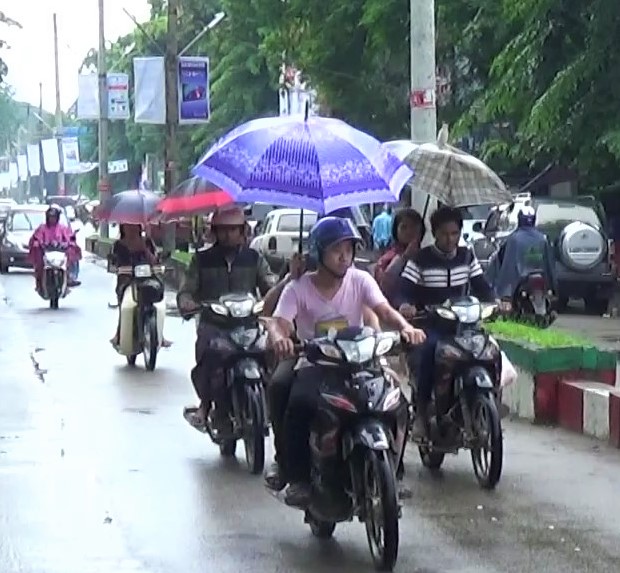
Navigating through the monsoon 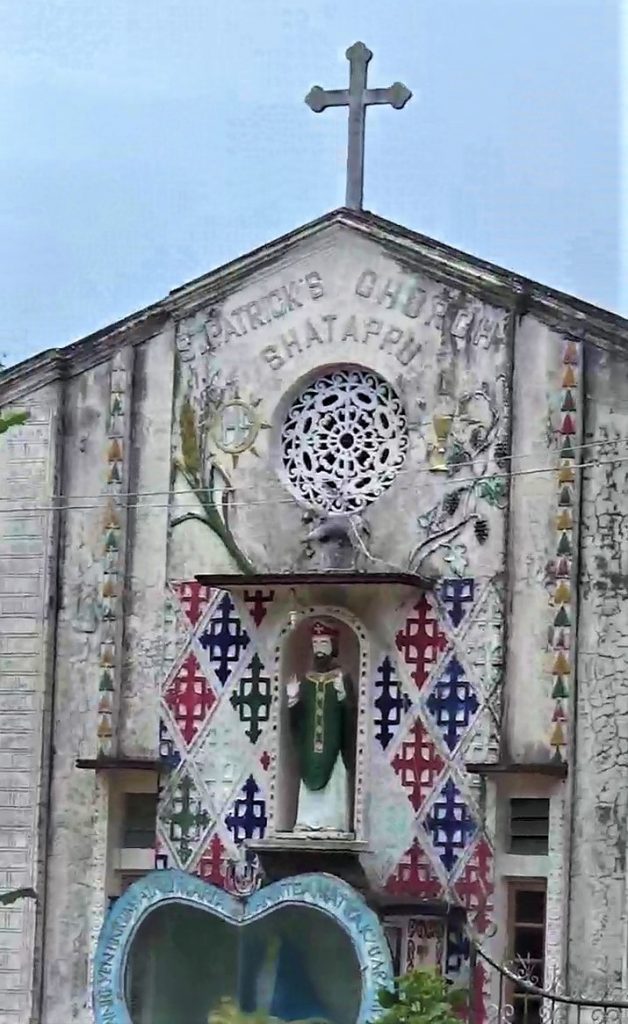
Church of St. Patrick in Myitkyina 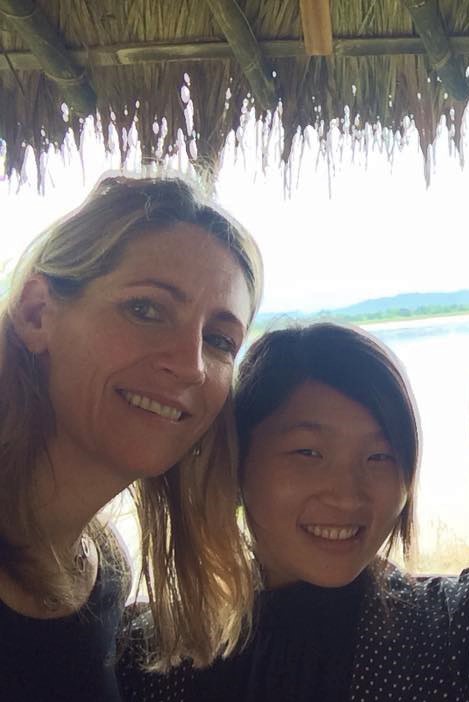
The fabulous Hnin Tay food connoisseur
Although historians will trace this influx of would-be god fearing inhabitants from the hills to the “town by the Big River” around the late 1890’s, it was really the introduction of a translated bible to Kachin by Rev. Dr. Ola Hanson in 1901 that spurred an evangelical fervor in Myitkyina. The missionaries also Romanized the main Kachin dialect, Jingphaw. The Bible and Christian hymns were translated into Jinghpaw, and the hill-dwellers, thanks to the church, now had their own written language. And, with education came self-esteem and ethnic pride — and an entirely new national consciousness evolved that would see the creation of a quite unique culture.
And, admittedly – I do look on in wonder and awe at the sheer volume of crosses I see displayed – everywhere. It seems no doorway or bamboo hut is exempt – people here are Christian and proud no matter what their station in life. Yet in the hustle and bustle of Kachin’s commercial hub I can’t help but notice something beyond the crucifix adorned doorways and sacred steeples. Something that captures more than the eye and the imagination – and that is the glorious smells of freshly baked bread rising up to meet the dawn of day. Gloria in excelsis deo – praiseworthy in smell, touch and taste – from bakery to market stalls and local shops – bread is everywhere. Mostly in the form of a local pastry type of delicacy known as Sa Mote. A not-so-secret treasure of this busy town. Picture a shortbread biscuit your grandma used to make meets a flakey buttery croissant finished with an Asian inspired coating of fresh sesame seeds then baked in a wood fired oven. Pure melt-in-your mouth little piece of heaven.
Feeling suitably inspired by my godly surrounds, I embark on a mission to find the best source of Sa Mot in town in the trusted hands of local food connoisseur Hnin Htay (aka: Mandy). First stop is Shwe Nin Zi where I meet San Thit the resident baker, and Daw Yan Lwan Proprietor a second generation Kachin of Chinese descent whose family has been in the business for over 60 years. San Thit shows me how they make the ‘a-sa’ or the filling of the pastry from a mix of butter, salt and sugar and the ‘a-ga’ or the outside pastry from oil and water and flour, before it is rolled and then sprinkled with ‘nan’ sesame seed. Her hands move deftly over dough rolling it into long cylindrical pieces that are then divvied up into individual balls with the perfect precision that can only be gained from years of practice. Before I know it the perfectly crafted balls the size of a Sa Mot are ready, filled, rolled, sprinkled and waiting for the oven.
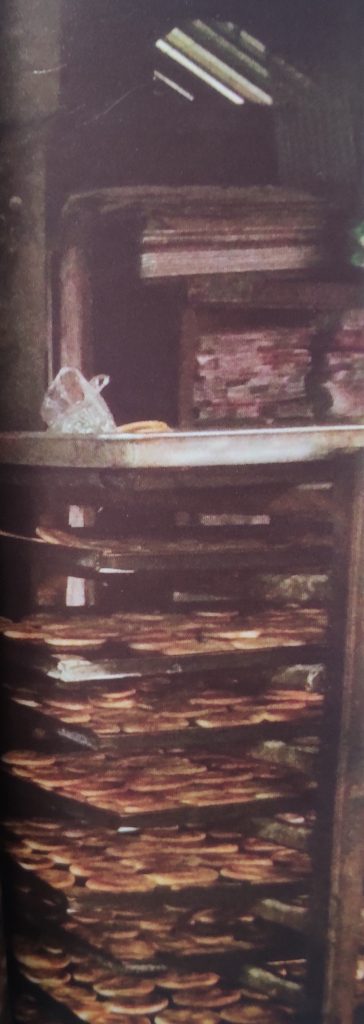
Your little piece of heaven 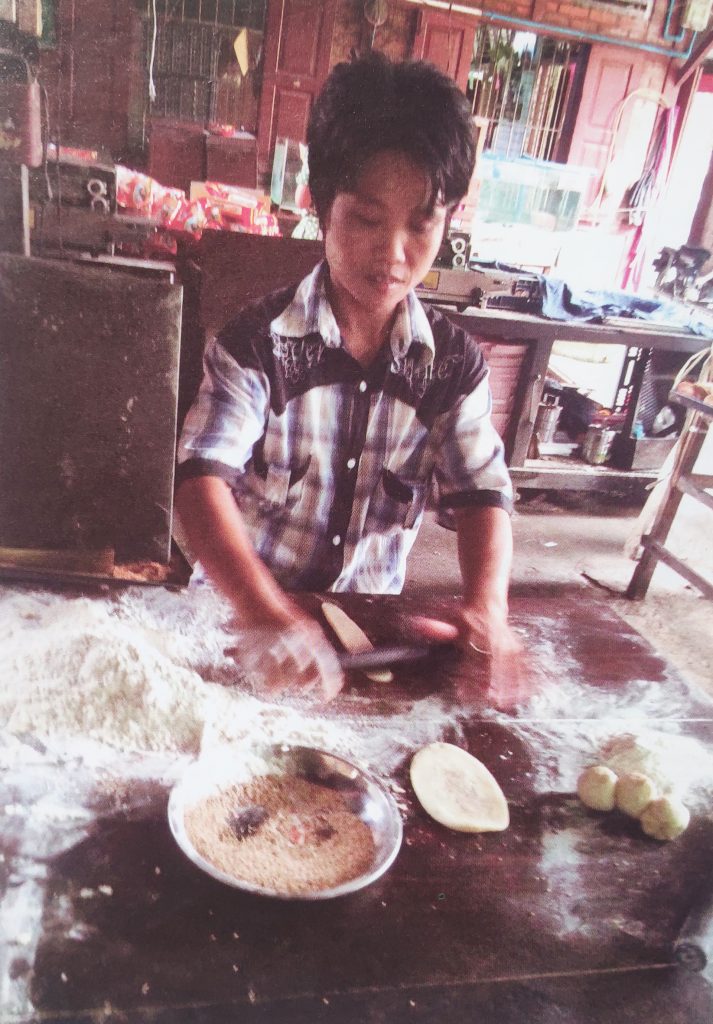
San Thit makes A-sa look easy! 
Artisanal brick oven
Shwe Nin Zi is a spectacular display of artisanal baking as you would have witnessed only in years gone by. The inside of the bakery is a long semi-enclosed structure of concrete and wood covered by a tin roof. Workers stoke the wood-fired brick oven and move between stations of dough making, rolling, cooking and finishing like a ballet of seasoned performers with an ease and grace that belies the bleak surrounds.
Dough is rolled on long wooden tables and groups of young and old women alike sit rolling, chatting, filling, sprinkling and generally spending the day together in a pretty tiny space they share with stacks of firewood, bags of flour, buckets of oil, and the occasional neighbourhood dog that tries to break in and thieve the finished product. Bicycles line the outside wall colourful umbrellas are hung on the inside walls, and everyone packs their traditional lunch of chekachin or curry and rice and eat together in the same room they work and rest.
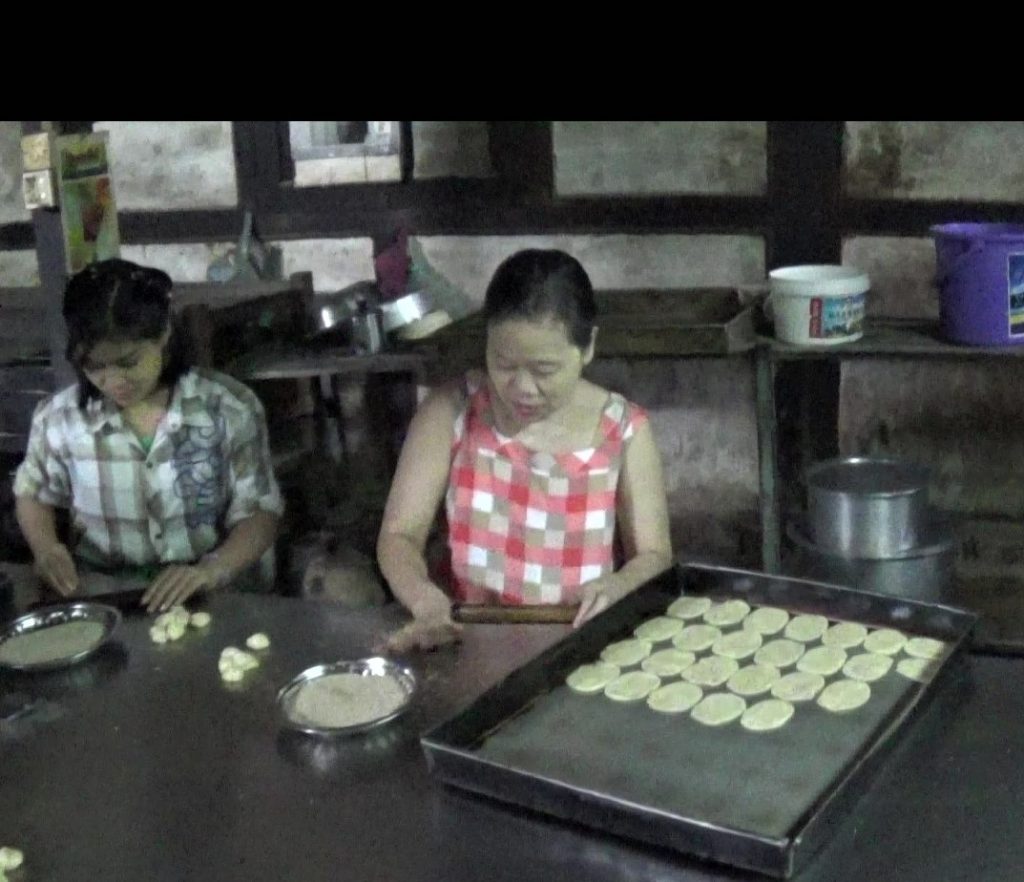
Yin Yin Sa Mot’s are divine! 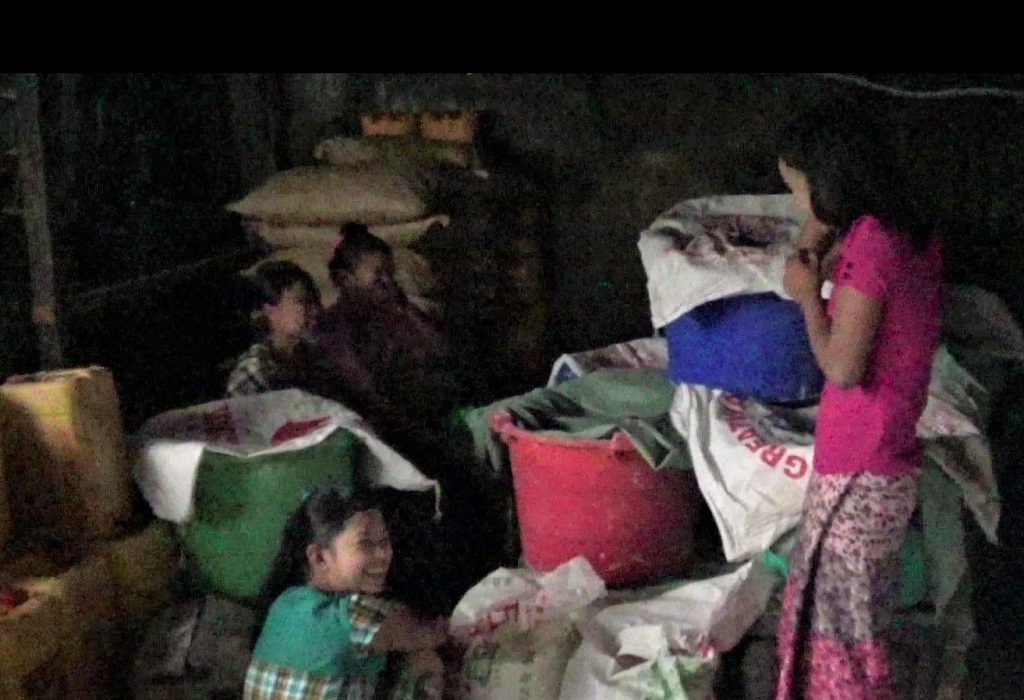
Behind the scenes
A section of the room is put aside for the packages and boxes. Sealing is completed with a candlestick. “We package seven biscuits in each bag, and then box 1,500 bags per day with no trouble” says Daw Yan Lwan – that’s a grand total of 10,500 Sa Mot’s that she then distributes across the whole state. She does not supply Yangon or Mandalay direct, but there is a wholesaler who buys some stock. They have a shelf life of two months, but Daw Yan Lwan says once you open them it is best to eat the whole pack. I do not find that advice difficult to abide by, and decide I’ll skip lunch and move along to the next stop.
Our next stop is Yin Yin Bakery to meet U Win Naing, a Kachin of Chinese descent who has been making Sa Mot for eleven years. He bakes 8,000 cookies per day requiring 210kg of flour and supplies three shops in Myitkyina. His eldest daughter lives in Yangon and is in the process of cutting a supply deal with one of Yangon’s largest supermarket chains.
The Yin Yin Sa Mot’s are much more delicate than Shwe Hnin Zi, a bit more flaky and light. The robust flavours from the dough are replaced by more delicate flavours from the sesame and the crisp feuilletine base. The buttery pastry melts into my taste buds in a way that is reminiscent of the angels singing – notes of nuts and oven roasted goodness ring on my tongue. Divine.
Our next stop is at Lucky Bakery – a quite modern outfit by local comparison – baking over 400 loaves of bread per day, 900 chicken buns, plus cakes, cookies, biscuits and sandwiches to a staggering tune of 300 kg of flour per day. Their shiny new equipment from Malaysia stands in stark contrast to the artisanal Sa Mot bakeries, but the owner U Prang Man – a Chinese Kachin – is away that day so I am unable to speak about the origins of their 20+ years in the baking industry. But, I am informed by his manager Zaw Aung San that their supply goes entirely to the state of Kachin alone.
Last stop and a quick loosening of the belt and we arrive at Yodaya Bakery to meet U Wa Pun and his daughter Win Win, first and second generation of Shan Chinese respectively. They have been baking their bread for twenty years on a made-to-order basis for clients who supply local restaurants and shops in Putao and Myitkyina. Preferring the more artisanal methods of baking, they have added a modern twist by manufacturing their own charcoal briquettes to power the operations, an activity they have spun off into a separate side business supplying other local restaurants and tea shops.
Myitkyina has been an important trading town between China and Burma since ancient times, and savvy merchants traded jade, teak, gold and khat cho rice – considered by some to be the best in the country. You will also find the Jingpo/Jinghpaw linguistic tribe of people present in both Kachin and in the neighbouring Yunnan Province of China. It seems that at some point, the bakers from China migrated over the hills of Yunnan to Kachin and set about supplying a largely rice eating population with baked goods.
As we roll back to our hotel that evening with bags of goodies for Yangon, one can’t help but wonder why the humble bakery is so pervasive and prolific in this northern outpost. Is it that the Christians break bread, the Chinese bake bread and somehow when they meet at the confluence of two rivers and the birthplace of the Ayeyarwaddy River it creates a special kind of divine revelation up here on the banks ‘near the big river’? Perhaps. Or, perhaps it is just the way the universe bequeaths us joy.
End notes:
Special thanks to Mandy Htay from SNS Projects & Mary San from Grace Grapefruit for assisting me and looking after me for the duration of my stay in Myitkyina. This article first appeared in a publication of My Magical Myanmar in October, 2015. They have allowed me to repost the story in my blog.
Links:
http://directory.ucanews.com/dioceses/myanmar-myitkyina/369
